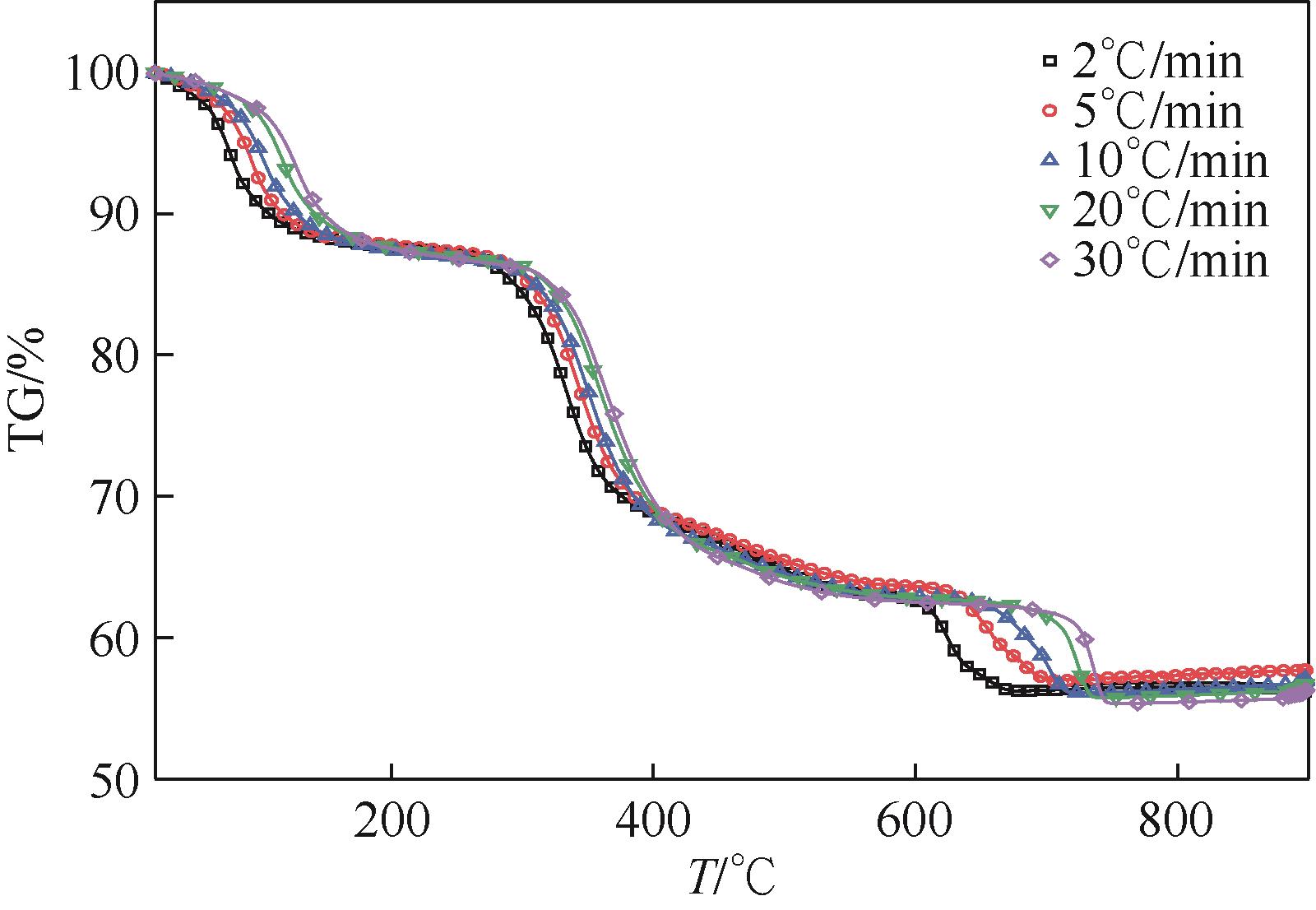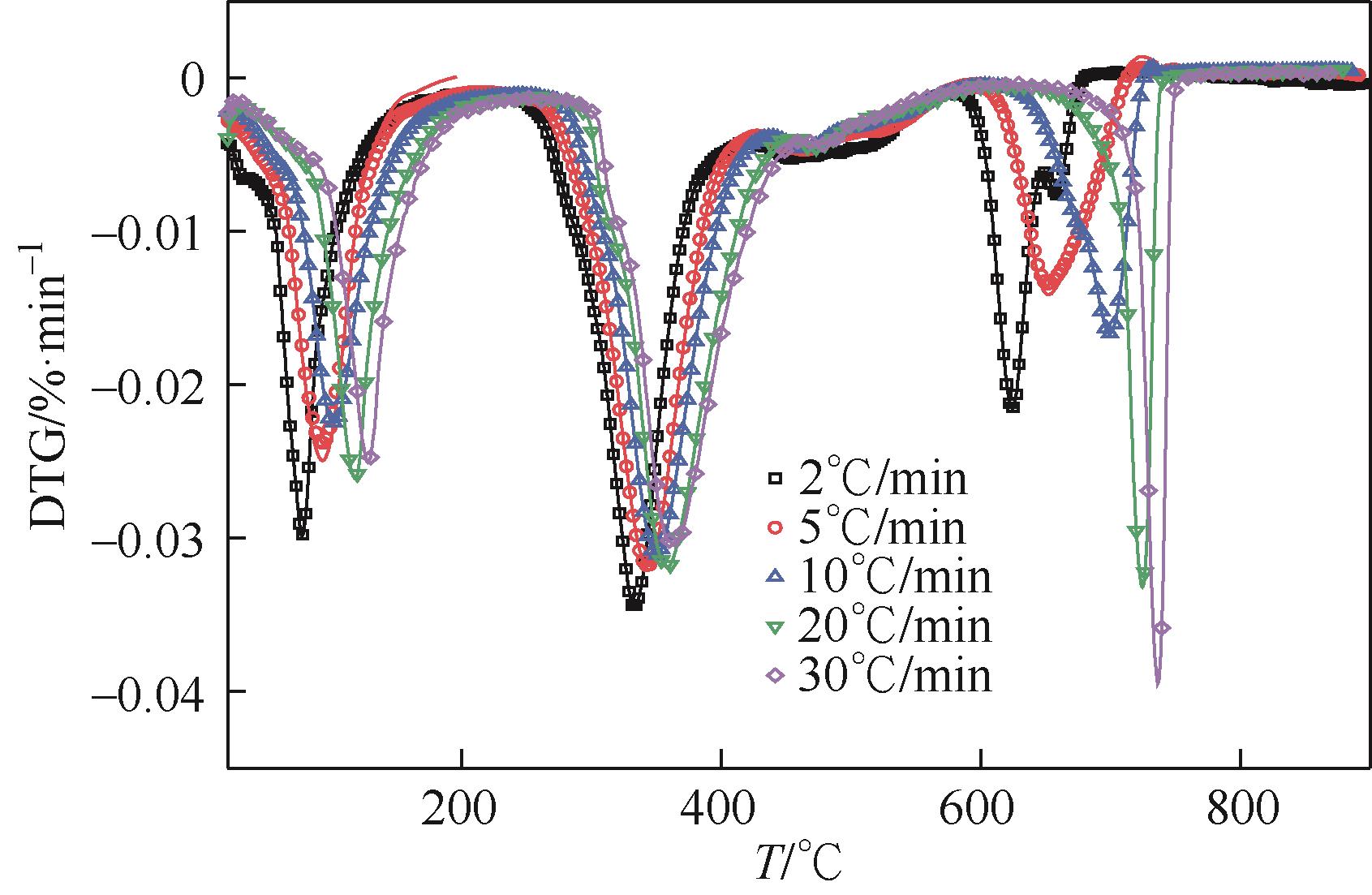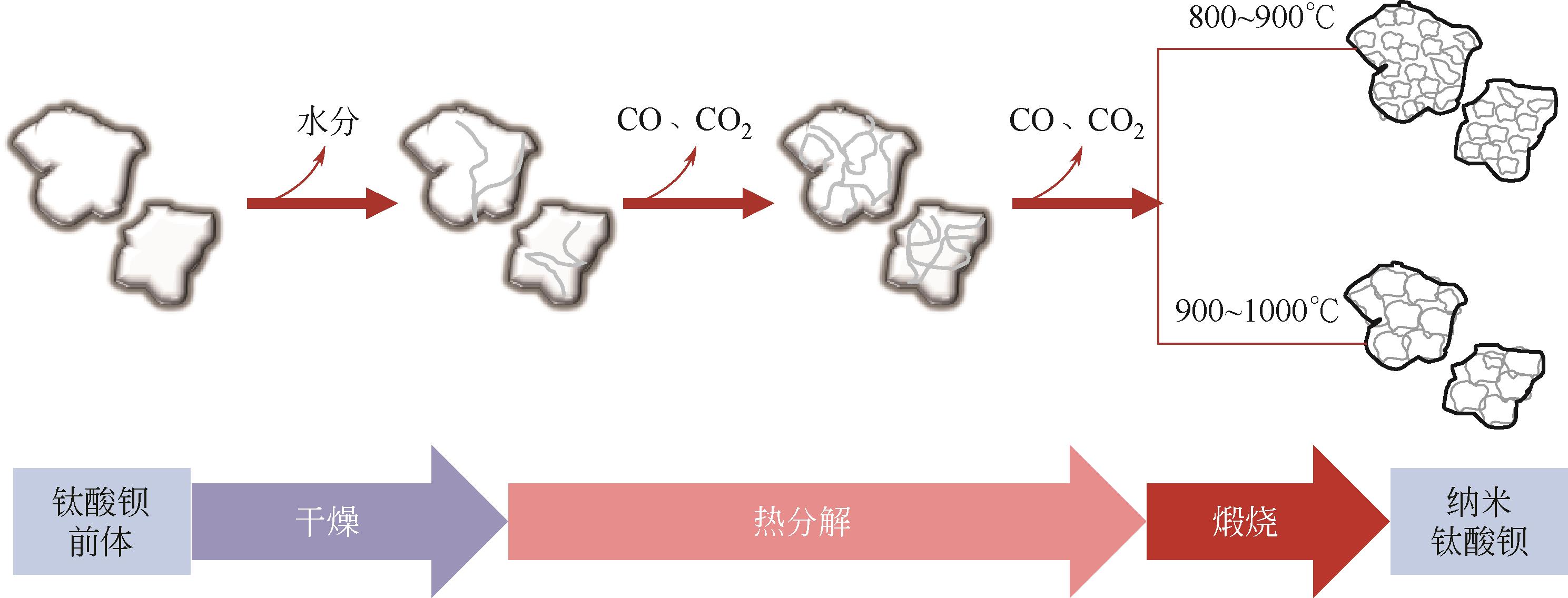Chemical Industry and Engineering Progress ›› 2024, Vol. 43 ›› Issue (7): 3987-3995.DOI: 10.16085/j.issn.1000-6613.2024-0069
• Materials science and technology • Previous Articles
Thermal decomposition kinetics and particle evolution characteristics of nano barium titanate precursor
- 1.China Electronics Engineering Design Institute Co. , Ltd. , Beijing 100142, China
2.S. Y. Technology, Engineering & Construction Co. , Ltd. , Beijing 100142, China
3.EAMT (Zhejiang) Co. , Ltd. , Haining 314415, Zhejiang, China
-
Received:2024-01-10Revised:2024-03-19Online:2024-08-14Published:2024-07-10 -
Contact:ZHANG Hao
纳米钛酸钡前体热分解反应动力学及颗粒演化机理
- 1.中国电子工程设计院股份有限公司,北京 100142
2.世源科技工程有限公司,北京 100142
3.元颉新材料科技(浙江)有限公司,浙江 海宁 314415
-
通讯作者:张昊 -
作者简介:张昊(1981—),男,硕士,高级工程师,研究方向为电子材料。E-mail:zhanghao@sdic.com.cn。
CLC Number:
Cite this article
ZHANG Hao, LU Xiaoming. Thermal decomposition kinetics and particle evolution characteristics of nano barium titanate precursor[J]. Chemical Industry and Engineering Progress, 2024, 43(7): 3987-3995.
张昊, 陆小明. 纳米钛酸钡前体热分解反应动力学及颗粒演化机理[J]. 化工进展, 2024, 43(7): 3987-3995.
share this article
Add to citation manager EndNote|Ris|BibTeX
URL: https://hgjz.cip.com.cn/EN/10.16085/j.issn.1000-6613.2024-0069
| 阶段 | 温度/℃ | 失重率/% | 热分解过程涉及的反应 | 编号 |
|---|---|---|---|---|
| 第一阶段 | 20~190 | 11 | 式(5) | |
| 第二阶段 | 190~410 | 20 | 式(6) | |
| 第三阶段 | 410~640 | 5 | 式(7) | |
| 第四阶段 | 640~720 | 7 | 式(8) 式(9) | |
| 第五阶段 | 720~1000 | 0 | — | — |
| 阶段 | 温度/℃ | 失重率/% | 热分解过程涉及的反应 | 编号 |
|---|---|---|---|---|
| 第一阶段 | 20~190 | 11 | 式(5) | |
| 第二阶段 | 190~410 | 20 | 式(6) | |
| 第三阶段 | 410~640 | 5 | 式(7) | |
| 第四阶段 | 640~720 | 7 | 式(8) 式(9) | |
| 第五阶段 | 720~1000 | 0 | — | — |
| 阶段 | 升温速率 /℃·min-1 | 温度/℃ | |||||
|---|---|---|---|---|---|---|---|
| α10% | α20% | α40% | α60% | α80% | α90% | ||
| 第一阶段 | 2 | 44 | 61 | 74 | 85 | 106 | 129 |
| 5 | 54 | 72 | 88 | 99 | 117 | 138 | |
| 10 | 60 | 81 | 98 | 111 | 133 | 156 | |
| 20 | 72 | 95 | 113 | 125 | 148 | 174 | |
| 30 | 73 | 100 | 121 | 134 | 156 | 180 | |
| 第二阶段 | 2 | 288 | 306 | 326 | 340 | 358 | 377 |
| 5 | 300 | 318 | 337 | 351 | 370 | 388 | |
| 10 | 310 | 327 | 345 | 360 | 380 | 398 | |
| 20 | 322 | 338 | 356 | 372 | 394 | 413 | |
| 30 | 327 | 344 | 362 | 378 | 402 | 421 | |
| 第三阶段 | 2 | 436 | 448 | 471 | 495 | 522 | 539 |
| 5 | 446 | 457 | 479 | 505 | 534 | 552 | |
| 10 | 451 | 461 | 480 | 506 | 536 | 555 | |
| 20 | 464 | 472 | 489 | 513 | 543 | 566 | |
| 30 | 470 | 478 | 494 | 516 | 544 | 569 | |
| 第四阶段 | 2 | 608 | 615 | 623 | 631 | 646 | 658 |
| 5 | 632 | 641 | 652 | 664 | 681 | 688 | |
| 10 | 656 | 668 | 684 | 696 | 705 | 709 | |
| 20 | 685 | 703 | 717 | 722 | 727 | 731 | |
| 30 | 705 | 722 | 730 | 735 | 740 | 743 | |
| 阶段 | 升温速率 /℃·min-1 | 温度/℃ | |||||
|---|---|---|---|---|---|---|---|
| α10% | α20% | α40% | α60% | α80% | α90% | ||
| 第一阶段 | 2 | 44 | 61 | 74 | 85 | 106 | 129 |
| 5 | 54 | 72 | 88 | 99 | 117 | 138 | |
| 10 | 60 | 81 | 98 | 111 | 133 | 156 | |
| 20 | 72 | 95 | 113 | 125 | 148 | 174 | |
| 30 | 73 | 100 | 121 | 134 | 156 | 180 | |
| 第二阶段 | 2 | 288 | 306 | 326 | 340 | 358 | 377 |
| 5 | 300 | 318 | 337 | 351 | 370 | 388 | |
| 10 | 310 | 327 | 345 | 360 | 380 | 398 | |
| 20 | 322 | 338 | 356 | 372 | 394 | 413 | |
| 30 | 327 | 344 | 362 | 378 | 402 | 421 | |
| 第三阶段 | 2 | 436 | 448 | 471 | 495 | 522 | 539 |
| 5 | 446 | 457 | 479 | 505 | 534 | 552 | |
| 10 | 451 | 461 | 480 | 506 | 536 | 555 | |
| 20 | 464 | 472 | 489 | 513 | 543 | 566 | |
| 30 | 470 | 478 | 494 | 516 | 544 | 569 | |
| 第四阶段 | 2 | 608 | 615 | 623 | 631 | 646 | 658 |
| 5 | 632 | 641 | 652 | 664 | 681 | 688 | |
| 10 | 656 | 668 | 684 | 696 | 705 | 709 | |
| 20 | 685 | 703 | 717 | 722 | 727 | 731 | |
| 30 | 705 | 722 | 730 | 735 | 740 | 743 | |
| 阶段 | 转化率/% | FWO模型 | KAS模型 | ||
|---|---|---|---|---|---|
| Ea /kJ·mol–1 | R2 | Ea /kJ·mol–1 | R2 | ||
| 第一阶段 | 10 | 76.86 | 0.985 | 75.29 | 0.982 |
| 20 | 66.79 | 0.994 | 63.01 | 0.992 | |
| 40 | 62.43 | 0.997 | 59.55 | 0.994 | |
| 60 | 63.93 | 0.999 | 60.43 | 0.998 | |
| 80 | 67.03 | 0.99 | 64.41 | 0.986 | |
| 90 | 70.32 | 0.977 | 65.96 | 0.966 | |
| 平均 | 67.89 | 0.99 | 64.77 | 0.986 | |
| 第二阶段 | 10 | 181.87 | 0.998 | 181.59 | 0.998 |
| 20 | 201.5 | 0.999 | 206.17 | 0.995 | |
| 40 | 226.35 | 0.997 | 216.69 | 0.99 | |
| 60 | 222.68 | 0.996 | 216.3 | 0.99 | |
| 80 | 205.81 | 0.993 | 215.11 | 0.989 | |
| 90 | 215.3 | 0.987 | 215.33 | 0.986 | |
| 平均 | 208.92 | 0.995 | 208.53 | 0.991 | |
| 第三阶段 | 10 | 327.39 | 0.978 | 332.19 | 0.977 |
| 20 | 385.38 | 0.976 | 393.01 | 0.974 | |
| 40 | 531.34 | 0.962 | 546.17 | 0.963 | |
| 60 | 619.11 | 0.969 | 638.09 | 0.967 | |
| 80 | 615.75 | 0.961 | 634.09 | 0.969 | |
| 90 | 485.28 | 0.978 | 496.54 | 0.977 | |
| 平均 | 494.04 | 0.971 | 506.68 | 0.971 | |
| 第四阶段 | 10 | 188.76 | 0.992 | 183.05 | 0.99 |
| 20 | 173.01 | 0.992 | 166.29 | 0.99 | |
| 40 | 173.64 | 0.996 | 166.81 | 0.995 | |
| 60 | 183.85 | 0.996 | 177.45 | 0.996 | |
| 80 | 212.64 | 0.995 | 207.56 | 0.994 | |
| 90 | 238.78 | 0.998 | 234.91 | 0.998 | |
| 平均 | 195.11 | 0.995 | 189.35 | 0.994 | |
| 阶段 | 转化率/% | FWO模型 | KAS模型 | ||
|---|---|---|---|---|---|
| Ea /kJ·mol–1 | R2 | Ea /kJ·mol–1 | R2 | ||
| 第一阶段 | 10 | 76.86 | 0.985 | 75.29 | 0.982 |
| 20 | 66.79 | 0.994 | 63.01 | 0.992 | |
| 40 | 62.43 | 0.997 | 59.55 | 0.994 | |
| 60 | 63.93 | 0.999 | 60.43 | 0.998 | |
| 80 | 67.03 | 0.99 | 64.41 | 0.986 | |
| 90 | 70.32 | 0.977 | 65.96 | 0.966 | |
| 平均 | 67.89 | 0.99 | 64.77 | 0.986 | |
| 第二阶段 | 10 | 181.87 | 0.998 | 181.59 | 0.998 |
| 20 | 201.5 | 0.999 | 206.17 | 0.995 | |
| 40 | 226.35 | 0.997 | 216.69 | 0.99 | |
| 60 | 222.68 | 0.996 | 216.3 | 0.99 | |
| 80 | 205.81 | 0.993 | 215.11 | 0.989 | |
| 90 | 215.3 | 0.987 | 215.33 | 0.986 | |
| 平均 | 208.92 | 0.995 | 208.53 | 0.991 | |
| 第三阶段 | 10 | 327.39 | 0.978 | 332.19 | 0.977 |
| 20 | 385.38 | 0.976 | 393.01 | 0.974 | |
| 40 | 531.34 | 0.962 | 546.17 | 0.963 | |
| 60 | 619.11 | 0.969 | 638.09 | 0.967 | |
| 80 | 615.75 | 0.961 | 634.09 | 0.969 | |
| 90 | 485.28 | 0.978 | 496.54 | 0.977 | |
| 平均 | 494.04 | 0.971 | 506.68 | 0.971 | |
| 第四阶段 | 10 | 188.76 | 0.992 | 183.05 | 0.99 |
| 20 | 173.01 | 0.992 | 166.29 | 0.99 | |
| 40 | 173.64 | 0.996 | 166.81 | 0.995 | |
| 60 | 183.85 | 0.996 | 177.45 | 0.996 | |
| 80 | 212.64 | 0.995 | 207.56 | 0.994 | |
| 90 | 238.78 | 0.998 | 234.91 | 0.998 | |
| 平均 | 195.11 | 0.995 | 189.35 | 0.994 | |
| 1 | 上官明楠, 王超莹, 赵昀云, 等. 四方相纳米钛酸钡粉体的制备及性能研究[J]. 绝缘材料, 2024, 57(2): 53-59. |
| SHANGGUAN Mingnan, WANG Chaoying, ZHAO Yunyun, et al. Study on preparation and properties of tetragonal phase nano-barium titanate powder[J]. Insulating Materials, 2024, 57(2): 53-59. | |
| 2 | 赵虔诚. 抗还原型钛酸钡基储能陶瓷材料的研究[D]. 北京: 清华大学, 2018. |
| ZHAO Qiancheng. Study on non-reducible Barium titanate based energy-storage ceramics[D]. Beijing: Tsinghua University, 2018. | |
| 3 | VINCENZO Buscaglia, RANDALL CLIVE A. Size and scaling effects in Barium titanate. An overview[J]. Journal of the European Ceramic Society, 2020, 40(11): 3744-3758. |
| 4 | 李雪梅. 固相法制备亚微米钛酸钡粉体的研究[D]. 重庆: 重庆理工大学, 2023. |
| LI Xuemei. Study on preparation of submicron Barium titanate powder by solid state method[D]. Chongqing: Chongqing University of Technology, 2023. | |
| 5 | 周斌. 抗还原型钛酸钡基材料的制备与性能研究[D]. 南昌: 南昌大学, 2023. |
| ZHOU Bin. Research on preparation and properties of non-reducible Barium titanate-based materials[D]. Nanchang: Nanchang University, 2023. | |
| 6 | PANOMSUWAN Gasidit, MANUSPIYA Hathaikarn. Correlation between size and phase structure of crystalline BaTiO3 particles synthesized by sol-gel method[J]. Materials Research Express, 2019, 6(6): 065062. |
| 7 | 白罗. 水热合成四方相钛酸钡粉体及其形貌调控与分散性研究[D]. 武汉: 武汉理工大学, 2022. |
| BAI Luo. Study on morphology regulation and dispersion of tetragonal phase Barium titanate powder by hydrothermal synthesis[D]. Wuhan: Wuhan University of Technology, 2022. | |
| 8 | 邵志鹏, 江伟辉, 冯果, 等. 沉淀法和NHSG法制备钛酸钡纳米粉体的对比研究[J]. 陶瓷学报, 2016, 37(1): 44-48. |
| SHAO Zhipeng, JIANG Weihui, FENG Guo, et al. Comparative study on the preparation of BatiO3 nano powder via precipitation method and NHSG method[J]. Journal of Ceramics, 2016, 37(1): 44-48. | |
| 9 | 徐阳, 包莹. 化学沉淀法制备微细粉体钛酸钡的研究[J]. 兰州工业学院学报, 2017, 24(6): 86-89. |
| XU Yang, BAO Ying. Preparation of ultrafine Barium titanate by chemical precipitation method[J]. Journal of Lanzhou Institute of Technology, 2017, 24(6): 86-89. | |
| 10 | CHEN Huei-Jyh, CHEN Yuwen. Hydrothermal synthesis of Barium titanate[J]. Industrial & Engineering Chemistry Research, 2003, 42(3): 473-483. |
| 11 | Sung-Soo RYU, YOON Dang-Hyok. Solid-state synthesis of nano-sized BaTiO3 powder with high tetragonality[J]. Journal of Materials Science, 2007, 42(17): 7093-7099. |
| 12 | 杨雅文. 溶胶-凝胶法制备钛酸钡纳米粉体[J]. 山西化工, 2024, 44(1): 42-43, 46. |
| YANG Yawen. Preparation of Barium titanate nanoparticles by sol-gel method[J]. Shanxi Chemical Industry, 2024, 44(1): 42-43, 46. | |
| 13 | 陈杰, 张晴, 车明超. 微波辅助草酸盐沉淀法制备四方相钛酸钡纳米粉体[J]. 人工晶体学报, 2017, 46(8): 1545-1551. |
| CHEN Jie, ZHANG Qing, CHE Mingchao. Preparation of tetragonal Barium titanate nanopowders by oxalate co-precipitation assisted with microwave method[J]. Journal of Synthetic Crystals, 2017, 46(8): 1545-1551. | |
| 14 | FRIEDMAN Henry L. Kinetics of thermal degradation of char-forming plastics from thermogravimetry. Application to a phenolic plastic[J]. Journal of Polymer Science Part C: Polymer Symposia, 1964, 6(1): 183-195. |
| 15 | SINGH Sanjay, PATIL Trilok, TEKADE Shyam P, et al. Studies on individual pyrolysis and co-pyrolysis of corn cob and polyethylene: Thermal degradation behavior, possible synergism, kinetics, and thermodynamic analysis[J]. Science of the Total Environment, 2021, 783: 147004. |
| 16 | HU Jinghui, GONG Li, HE Jiyu, et al. Studies on multistep thermal decomposition behavior of polytriazole polyethylene oxide-tetrahydrofuran elastomer[J]. Polymers for Advanced Technologies, 2020, 31(4): 749-758. |
| 17 | VENKATESH M, RAVI P, TEWARI Surya P. Isoconversional kinetic analysis of decomposition of nitroimidazoles: Friedman method vs. Flynn-Wall-Ozawa method[J]. The Journal of Physical Chemistry A, 2013, 117(40): 10162-10169. |
| 18 | SINDHU N V, MURALEEDHARAN K. Kinetic study of the multistep thermal behaviour of Barium titanyl oxalate prepared via chemical precipitation method[J]. Journal of Thermal Analysis and Calorimetry, 2019, 136(3): 1295-1306. |
| 19 | XU Jianfei, TSUTAI Sakae, HAYASHI Shigeo, et al. Thermal decomposition process of Barium titanyl oxalate tetrahydrate[J]. Journal of the Ceramic Society of Japan, 1999, 107(1241): 27-30. |
| 20 | 李改改, 姜鹏飞, 黄佳齐, 等. 富油煤热解过程动力学参数变化规律研究[J]. 煤炭技术, 2023, 42(10): 52-56. |
| LI Gaigai, JIANG Pengfei, HUANG Jiaqi, et al. Study on change of kinetic parameters of tar-rich coal during pyrolysis[J]. Coal Technology, 2023, 42(10): 52-56. | |
| 21 | 刘晓林, 高礼杰, 付极文, 等. 热处理过程对纳米钛酸钡相变的影响研究[J]. 北京化工大学学报(自然科学版), 2004, 31(6): 13-17. |
| LIU Xiaolin, GAO Lijie, FU Jiwen, et al. Effect of heat treatment on phase transition of Barium titanate[J]. Journal of Beijing University of Chemical Technology, 2004, 31(6): 13-17. |
| [1] | DING Lu, WANG Peiyao, KONG Lingxue, BAI Jin, YU Guangsuo, LI Wen, WANG Fuchen. Progress on reaction models for coal gasification processes [J]. Chemical Industry and Engineering Progress, 2024, 43(7): 3593-3612. |
| [2] | XING Lei, MIAO Chunyu, JIANG Minghu, ZHAO Lixin, CAI Meng, LI Xinya. Analysis of flow field characteristics and performance of hydrocyclone in blocked conditions [J]. Chemical Industry and Engineering Progress, 2024, 43(7): 3776-3786. |
| [3] | ZHAO Peitao, FU Binbin, ZHAO Quan, ZUO Wu, ZHOU Haiyun, HAN Dongtai. Thermal decomposition of plastics via low pressure and superheated solvent steam and its characteristics [J]. Chemical Industry and Engineering Progress, 2024, 43(6): 3420-3429. |
| [4] | MA Dong, XIE Guilin, TIAN Zhihua, WANG Qinhui, ZHANG Jianguo, SONG Huilin, ZHONG Jin. Analysis of high temperature reduction process of phosphogypsum by coal gasification fine slag in fluidized bed [J]. Chemical Industry and Engineering Progress, 2024, 43(6): 3479-3491. |
| [5] | HUANG Zibo, ZHOU Wenjing, WEI Jinjia. Product evolution and reaction mechanism of low-rank coal pyrolysis based on ReaxFF MD simulation [J]. Chemical Industry and Engineering Progress, 2024, 43(5): 2409-2419. |
| [6] | ZHOU Qiuming, NIU Congcong, LYU Shuaishuai, LI Hongwei, WEN Fuli, XU Run, LI Mingfeng. Promoting CO2 hydrogenation to methanol through product transformation and separation [J]. Chemical Industry and Engineering Progress, 2024, 43(5): 2776-2785. |
| [7] | PANG Shuxin, WANG Hao, WANG Jianyu, ZHU Kake, LIU Zhicheng. Thermodynamic calculation of methane combined reforming to synthesis gas process based on Aspen Plus [J]. Chemical Industry and Engineering Progress, 2024, 43(5): 2890-2900. |
| [8] | WANG Debin, LIN Mengyu, YANG Xue, DONG Dianquan. Preparation and adsorption properties of zinc-doped titanium-based cesium ion sieves [J]. Chemical Industry and Engineering Progress, 2024, 43(4): 1953-1961. |
| [9] | HE Fachao, LIU Hailong, LI Changfeng, WANG Junfeng. Effect of non-uniform electric field on bubble dispersion characteristics in high-viscosity fluid [J]. Chemical Industry and Engineering Progress, 2024, 43(4): 1774-1782. |
| [10] | LI Jing, FANG Qing, ZHOU Wenhao, WU Guoliang, WANG Jiahui, ZHANG Hua, NI Hongwei. Effect of baffle configuration on the multiphase flow behaviors of vanadium shale leaching tank [J]. Chemical Industry and Engineering Progress, 2024, 43(2): 619-627. |
| [11] | WANG Kexu, ZHANG Xiangping, WANG Hongyan, BAI Yan, WANG Hui. Progress on current-responsive catalysts and their applications in intensifying typical reactions [J]. Chemical Industry and Engineering Progress, 2024, 43(1): 49-59. |
| [12] | WANG Yunfei, QIN Rui, ZHENG Lijun, LI Yan, LI Qingping. Research progress of rotating packed bed simulation through CFD method [J]. Chemical Industry and Engineering Progress, 2023, 42(S1): 1-9. |
| [13] | HUANG Yiping, LI Ting, ZHENG Longyun, QI Ao, CHEN Zhenglin, SHI Tianhao, ZHANG Xinyu, GUO Kai, HU Meng, NI Zeyu, LIU Hui, XIA Miao, ZHU Kai, LIU Chunjiang. Hydrodynamics and mass transfer characteristics of a three-stage internal loop airlift reactor [J]. Chemical Industry and Engineering Progress, 2023, 42(S1): 175-188. |
| [14] | SUN Jipeng, HAN Jing, TANG Yangchao, YAN Bowen, ZHANG Jieyao, XIAO Ping, WU Feng. Numerical simulation and optimization of operating parameters of sulfur wet molding process [J]. Chemical Industry and Engineering Progress, 2023, 42(S1): 189-196. |
| [15] | WANG Shengyan, DENG Shuai, ZHAO Ruikai. Research progress on carbon dioxide capture technology based on electric swing adsorption [J]. Chemical Industry and Engineering Progress, 2023, 42(S1): 233-245. |
| Viewed | ||||||
|
Full text |
|
|||||
|
Abstract |
|
|||||








